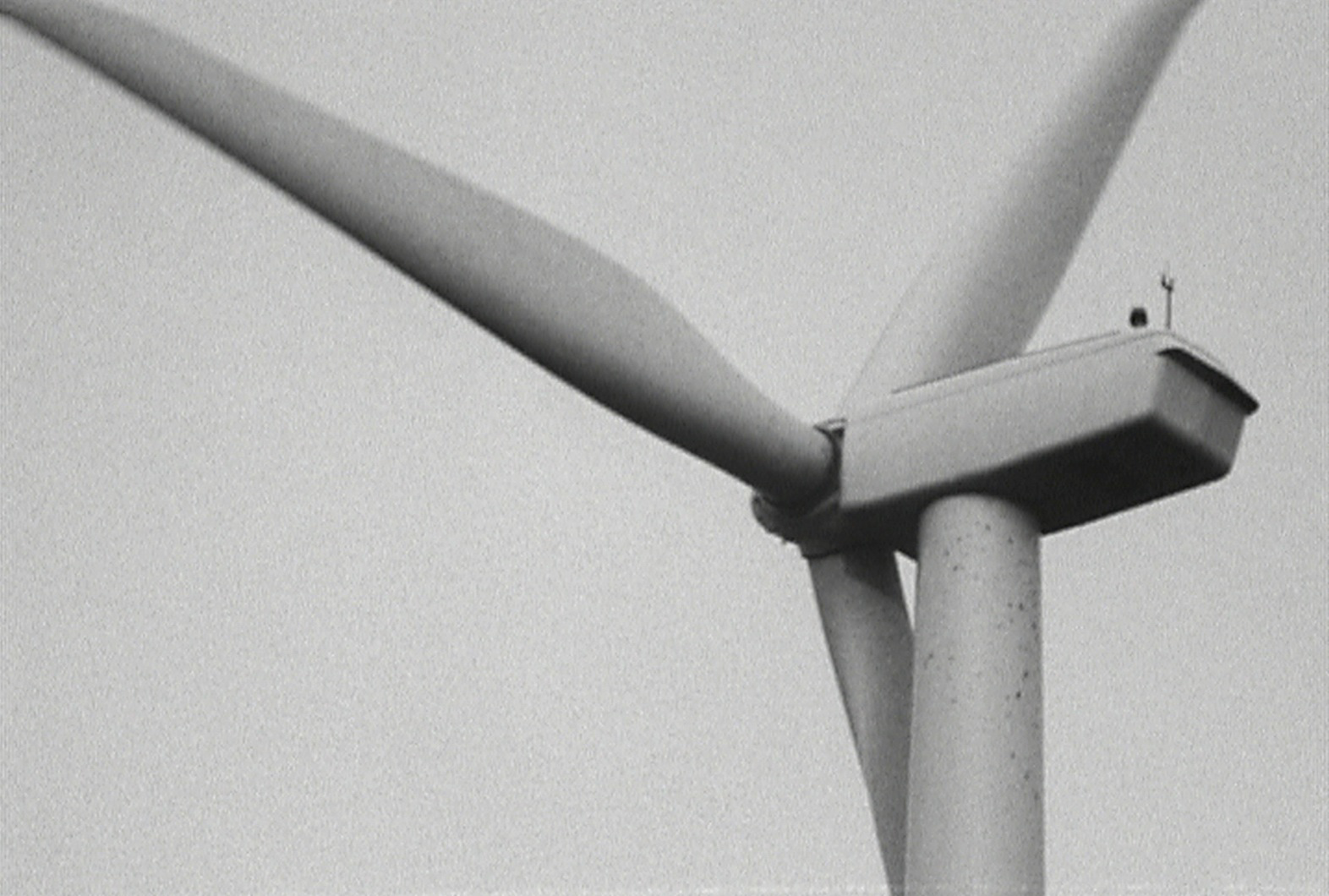A woman sits in the driver’s seat of a moving van, holding a page of printed text between her thumb and forefinger. She lights a cigarette, pauses, and then introduces its glowing end to the paper, watching flakes of ash fall into her lap as serenely as if they were falling snow.
This is the opening scene of “Nacelle,” a video installation at Blanc Gallery by former University of Chicago MFA student Marco Ferrari. It centers on a small film crew that spends most of the video enclosed in the back of a moving van, stopping to collect B-roll footage at five locations in and around Chicago. As the video progresses, the scene in the van becomes increasingly chaotic—equipment clatters to the floor and hands entangle themselves in rope. The five locations in the video mirror this collapse of order, each introducing a new element of confusion. The DeKalb Wind Turbine Farm reminds the crew of their paradoxical attempt to capture immaterial emotions and ideas using mechanical equipment. The Cook County Department of Corrections’ Division XI Facility taunts them with an impenetrable facade, reflecting an essential concern in filmmaking: how to represent an interior using a medium that deals exclusively in exteriors.
The bedlam reaches its climax on Lower Wacker Drive. “Lower Wacker was this kind of representation of what was happening inside the minds of these characters, so it was a very dark, eerie environment,” explained Ferrari in a post-opening interview.
Ferrari’s work is as much a meditation on existence as it is a commentary on the limitations of film. The film crew’s futile attempt to find and represent meaning highlights the void that underlies objects without meaning or signification. The crew asks the material world to show them something that feels like spiritual, emotional, or intellectual greatness, both in order to affirm that film is a worthwhile pursuit and that they, as human beings, are more than just their bodies. Finding nothing but blank, silent physicality, they descend into a state of disarray, chaos mounting within the truck as the barriers to real comprehension become increasingly severe at each location.
Ferrari says “Nacelle” asks the question: “Do you engage with the environment, or do you just remain in the truck and continue to observe?” It might be more accurate to say that his piece asks: can you genuinely engage with the environment? And is there any meaning beyond observation?
Because the gallery played the video on a continuous loop, the initial scene could have easily been the film’s ending. When you invert the video this way, the answer to the question of meaning is simple: it doesn’t exist. The film crew’s struggle to find and represent meaning devolves from a straightforward pursuit into nonsensical fumbling in the back of a truck, a movement tracked by visual representations of the written word. Each time the truck stops and the driver opens her door, fragments of paper covered in text fall onto the street. The beginning of “Nacelle,” viewed as its final moment, turns this trickling loss of intelligibility into a flood symbolized by the literal destruction of language—a smoldering page.
But, as Samuel Beckett famously wrote in The Unnameable, “I can’t go on, I’ll go on.” Ferrari doesn’t let his suspicion that existence is utterly meaningless stop him from taking a serious look at real-world issues. Superimposed on his existential concerns in both “Nacelle” and his other films are more literal questions about the relationship of people to places. In his 2013 video Skyway, he addresses de-industrialization in East Chicago and its effect on the individual.
“I definitely don’t want to come across as saying there is a correct use of place,” he says, “but in an area like Skyway, where you really see the environment being affected by how we engage with it, and then being kind of forgotten about, and then being re-activated with casinos, being there is very heavy, visually heavy. Even the air is heavy.”
Ferrari includes shots of himself in the video in order to emphasize the alienation he sees such misuses of place causing. While he resists making prescriptive statements about uses of place, Ferrari’s work as a Film Fellow at Black Cinema House—part of Theaster Gates’s initiative to reinvigorate the Greater Grand Crossing neighborhood—is evidence of his preferences.
After meeting Gates at an MFA critique, Ferrari sought his help launching an outdoor projection project in the Woodlawn neighborhood that would “really just get in touch with the neighbors there and reflect a little bit what’s going on in terms of development, because a lot of changes are happening on the South Side.” Gates, in turn, offered Ferrari the curatorial position at Black Cinema House and proposed a version of Ferrari’s projection project made in conjunction with BCH, slated to appear in early June.
“There are a lot of empty spaces,” Ferrari says. For a moment it’s unclear whether he is referring to the vast emptiness “Nacelle” suggests or the empty lots of Greater Grand Crossing. “But maybe it’s a time for us to kind of pause and think exactly how we want to reform the neighborhoods.” Though film crew of “Nacelle” may not have been able to find meaning in physical places, the artist himself hasn’t quite yet given up hope.
Blanc Gallery, 4445 S. King Drive. Saturdays, 1pm-3pm. Through May 1. (773) 373-4320. blancchicago.com

